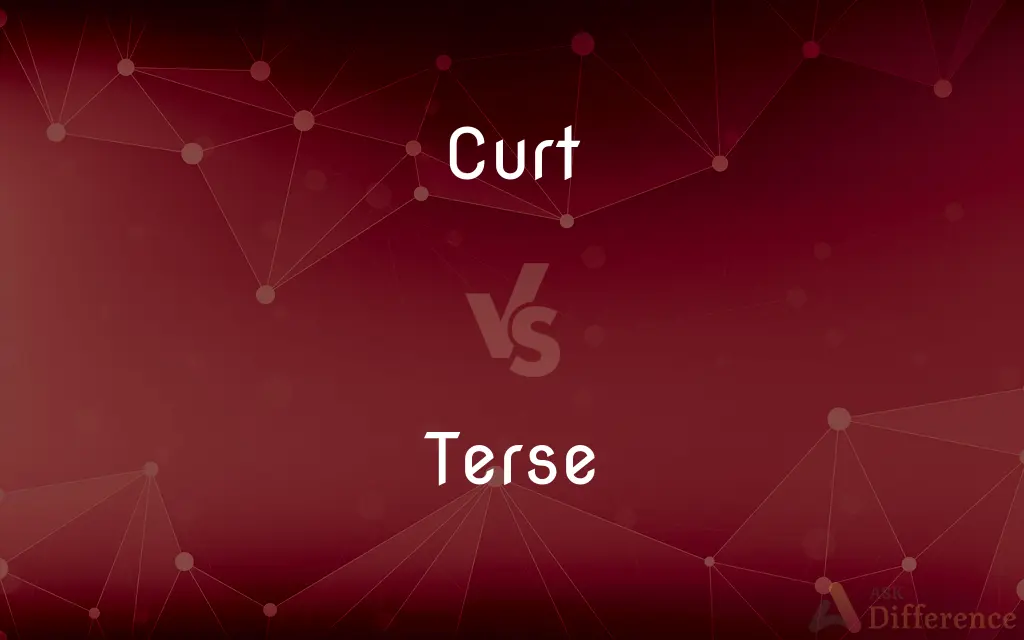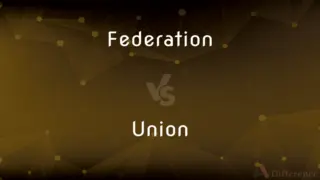Curt vs. Terse — What's the Difference?
By Fiza Rafique & Maham Liaqat — Updated on April 1, 2024
Curt refers to rudely brief or abrupt in speech or manner, while terse means sparing in the use of words; concise to the point of seeming rude or mysterious.

Difference Between Curt and Terse
Table of Contents
ADVERTISEMENT
Key Differences
Curt often carries a negative connotation, suggesting not just brevity but a brusqueness or abruptness that can be perceived as impolite or dismissive. It implies a lack of the usual courtesies or embellishments in communication, which can lead to misunderstandings or hurt feelings. On the other hand, terse communication is also brief and to the point, but it focuses more on the efficiency of language rather than the tone or manner. Terse can imply a deliberate choice to be concise, possibly for effect or because the situation calls for it, without necessarily intending to be rude.
While curt behavior is often viewed unfavorably because it can reflect a person's impatience or irritability, terse language can be seen as a stylistic or pragmatic choice. For instance, a terse reply in a high-pressure situation might be valued for its clarity and brevity. However, because terseness reduces communication to its bare essentials, it can sometimes be interpreted as cold or aloof, similar to curt responses.
In literature or writing, a terse style is often appreciated for its ability to convey much with few words, demonstrating the writer's skill in efficient communication. Meanwhile, a character described as curt might be perceived as lacking in social graces or intentionally distancing themselves from others.
The difference between being curt and terse thus lies in the intention and the reception. Curt behavior is more likely to be interpreted as rudely brief due to its abrupt nature, whereas terseness, while also brief, is often seen as simply a preference for conciseness, even though it can be perceived as mysterious or even rude if misunderstood.
Understanding the nuances between curt and terse is crucial in social interactions and communication. Recognizing the potential for misinterpretation can help individuals navigate conversations more effectively, choosing their words carefully to convey the desired tone and level of politeness.
ADVERTISEMENT
Comparison Chart
Definition
Rudely brief or abrupt in speech or manner.
Concise to the point of seeming rude or mysterious.
Connotation
Negative, implying impoliteness or dismissiveness.
Neutral, focusing on efficiency and conciseness.
Intention
May reflect impatience or irritability.
Reflects a choice for brevity, possibly for effect.
Reception
Often viewed unfavorably due to perceived rudeness.
Can be appreciated for clarity, though sometimes seen as cold.
Application
More about manner or tone in communication.
More about the choice and style of communication.
Compare with Definitions
Curt
Abruptly brief in communication.
His curt reply left her feeling dismissed.
Terse
Chosen for brevity or effect.
The author's terse style captivated readers with its precision.
Curt
Perceived negatively in social contexts.
His curt farewell soured the mood.
Terse
Valued for clarity in certain situations.
In emergencies, terse communication can save lives.
Curt
Lacking usual social niceties.
Her curt nod was the only acknowledgment she gave.
Terse
Economical in words, concise.
Her terse instructions were clear and to the point.
Curt
Often resulting from impatience or irritation.
Exhausted, his responses became curt.
Terse
Can seem cold or mysterious.
His terse response left more questions than answers.
Curt
Reflecting impoliteness or brusqueness.
The manager's curt manner intimidated the staff.
Terse
Sometimes misunderstood as rudeness.
His terse email was intended to be efficient, not rude.
Curt
Rudely brief
His reply was curt
Terse
Sparing in the use of words; abrupt
A terse statement
Curt
Rudely brief or abrupt, as in speech or manner
Was curt and businesslike in the meeting.
Acknowledged him with a curt nod.
Terse
Brief and to the point; effectively concise
A terse one-word answer.
Curt
Terse or condensed
A curt text message.
Terse
(by extension) Of speech or style: brief, concise, to the point.
Curt
Brief or terse, especially to the point of being rude.
Terse
(by extension) Of manner or speech: abruptly or brusquely short; curt.
Curt
Short or concise.
Terse
(obsolete) Burnished, polished; fine, smooth; neat, spruce.
Curt
To cut, cut short, shorten.
Terse
Appearing as if rubbed or wiped off; rubbed; smooth; polished.
Many stones, . . . although terse and smooth, have not this power attractive.
Curt
Characterized by excessive brevity; short; rudely concise; as, curt limits; a curt answer.
The curt, yet comprehensive reply.
Terse
Refined; accomplished; - said of persons.
Curt
Marked by rude or peremptory shortness;
Try to cultivate a less brusque manner
A curt reply
The salesgirl was very short with him
Terse
Elegantly concise; free of superfluous words; polished to smoothness; as, terse language; a terse style.
Terse, luminous, and dignified eloquence.
A poet, too, was there, whose verseWas tender, musical, and terse.
"In eight terse lines has Phædrus told(So frugal were the bards of old)A tale of goats; and closed with grace,Plan, moral, all, in that short space."
Curt
Brief and to the point; effectively cut short;
A crisp retort
A response so curt as to be almost rude
The laconic reply; `yes'
Short and terse and easy to understand
Terse
Brief and to the point; effectively cut short;
A crisp retort
A response so curt as to be almost rude
The laconic reply; `yes'
Short and terse and easy to understand
Common Curiosities
Is a terse writing style always preferred?
It depends on the audience and purpose. Brevity is valued in many professional settings, but fuller explanations may be needed elsewhere.
Is it better to be curt or terse?
Context matters; terseness can be effective for clarity, but being curt is often perceived negatively.
How can one avoid the negative implications of being terse?
By ensuring the tone, context, and relationship with the audience accommodate brevity without offending.
Can terseness be polite?
Yes, if used judiciously and with awareness of how it may be received.
How does culture affect perceptions of curt and terse communication?
Cultural norms heavily influence what is considered polite or rude, affecting how curt or terse messages are interpreted.
Can curt behavior be justified?
In some scenarios, such as urgent situations requiring quick action, but generally, it's seen as lacking tact.
Why might someone choose to be curt?
Due to impatience, irritation, or sometimes as a defensive or distancing mechanism.
Why is terseness sometimes seen as mysterious?
Because it leaves more unsaid than said, prompting speculation about the underlying meaning.
How can terseness be effectively used in communication?
By balancing brevity with enough information to avoid misunderstandings, especially in sensitive or complex matters.
Can someone be unintentionally curt?
Yes, especially if they are distracted, stressed, or unaware of how their communication is perceived.
Share Your Discovery

Previous Comparison
Shack vs. Shanty
Next Comparison
Federation vs. UnionAuthor Spotlight
Written by
Fiza RafiqueFiza Rafique is a skilled content writer at AskDifference.com, where she meticulously refines and enhances written pieces. Drawing from her vast editorial expertise, Fiza ensures clarity, accuracy, and precision in every article. Passionate about language, she continually seeks to elevate the quality of content for readers worldwide.
Co-written by
Maham Liaqat













































